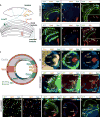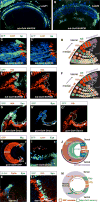A Unique Class of Neural Progenitors in the Drosophila Optic Lobe Generates Both Migrating Neurons and Glia
- PMID: 27149843
- PMCID: PMC5154769
- DOI: 10.1016/j.celrep.2016.03.061
A Unique Class of Neural Progenitors in the Drosophila Optic Lobe Generates Both Migrating Neurons and Glia
Abstract
How neuronal and glial fates are specified from neural precursor cells is an important question for developmental neurobiologists. We address this question in the Drosophila optic lobe, composed of the lamina, medulla, and lobula complex. We show that two gliogenic regions posterior to the prospective lamina also produce lamina wide-field (Lawf) neurons, which share common progenitors with lamina glia. These progenitors express neither canonical neuroblast nor lamina precursor cell markers. They bifurcate into two sub-lineages in response to Notch signaling, generating lamina glia or Lawf neurons, respectively. The newly born glia and Lawfs then migrate tangentially over substantial distances to reach their target tissue. Thus, Lawf neurogenesis, which includes a common origin with glia, as well as neuronal migration, resembles several aspects of vertebrate neurogenesis.
Copyright © 2016 The Authors. Published by Elsevier Inc. All rights reserved.
Figures





References
Grants and funding
LinkOut - more resources
Full Text Sources
Other Literature Sources
Molecular Biology Databases

